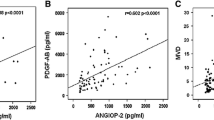Abstract
Angiogenesis plays a significant role in the pathogenesis of multiple myeloma (MM). We have measured concentrations of angiogenesis activators, including vascular endothelial growth factor (VEGF), basic fibroblast growth factor, and hepatocyte growth factor (HGF), and inhibitors, including endostatin, thrombospondin-1 (TSP-1), and angiostatin in the peripheral and bone marrow blood of MM patients at diagnosis and after high-dose chemotherapy. We have analyzed 96 patients with secretory MM. Serial measurements of angiogenesis factors/inhibitors were analyzed in the plasma by subgroups based on the best treatment response. Concentrations of angiogenic factors were determined in the peripheral blood and bone marrow plasma. There were significant decreases of VEGF and HGF levels and a significant increase in TSP-1 concentrations in the bone marrow plasma of patients who achieved complete or very good partial response in contrast to those who had partial or no response. VEGF and HGF levels decrease but those of TSP-1 increase after successful treatment for MM, indicating a reduction in the rate of angiogenesis.
Similar content being viewed by others
References
Adam Z, Hajek R, Mayer J et al (1999) Multiple myeloma and other monoclonal gammapathies. Masaryk university, Brno 325
Vacca A, Ribatti D (1994) Bone marrow angiogenesis and progression in multiple myeloma. Br J Haematol 87(3):503–508
Vacca A, Ribatti D (2006) Bone marrow angiogenesis in multiple myeloma. Leukemia 20(2):193–199
Rajkumar SV, Leong T, Roche PC et al (2000) Prognostic value of bone marrow angiogenesis in multiple myeloma. Clin Cancer Res (United States) 6(8):3111–3116
Orpana A (2002 Feb) Angiogenic and lymphangiogenic molecules in hematological malignancies. Leuk Lymphoma 43(2):219–224
Neben K, Moehler T, Egerer G (2001) High plasma basic fibroblast growth factor concentration is associated with response to thalidomide in progressive multiple myeloma. Clin Cancer Res 7(9):2675–2681
Ščudla V et al (2006) Comparison of serum levels of selected biological parameters in monoclonal gammopathy of undetermined significance and multiple myeloma. Vnitr Lek 52(3):232–240 Czech
Iwasaki T (2002) Predicting treatment responses and disease progression in myeloma using serum vascular endothelial growth factor and hepatocyte Folkman, J.: role of angiogenesis in tumor growth and metastasis. Semin Oncol 20:15–18
Sezer O, Jakob C, Eucker J et al (2001) Serum levels of the angiogenic cytokines basic fibroblast growth factor (bFGF), vascular endothelial growth factor (VEGF) and hepatocyte growth factor (HGF) in multiple myeloma. Eur J Haematol 66(2):83–88
Sato N et al (2002 Apr) Elevated level of plasma basic fibroblast growth factor in multiple myeloma correlates with increased disease activity. Jpn J Cancer Res 93(4):459–466
Wrobel T, Mazur G, Surowiak P et al (2003) Increased expression of vascular endothelial growth factor in bone marrow of multiple myeloma patients. Eur J Intern Med 14(2):98–100
Standal T, Abildgaard N, Fagerli U, et al HGF inhibits BMP-induced osteoblastogenesis: possible implications for the bone disease of multiple myeloma. Blood 109:3024-3030
Voest E, D’Amore P (2001) Tumor angiogenesis and microcirculation. Marcel Dekker AG, New York, p 623s
Urbanska-Rys J (2003) High serum level of endostatin in multiple myeloma at diagnosis but not in the plateau phase after treatment. Mediat Inflamm 12(4):229–235
Du W et al (2006) NK4, an antagonist of hepatocyte growth factor (HGF), inhibits growth of multiple myeloma cells in vivo; molecular targeting of angiogenic growth factor. Blood 19; (Epub ahead of print)
Attal M, Harousseau JL, Stoppa AM (1996) A prospective, randomized trial of autologous bone marrow transplantation and chemotherapy in multiple myeloma. Intergroupe Français du Myélome. N Engl J Med 335(2):91–97
Hajek R, Spicka I, Scudla V et al (2007) Consolidation therapy based on conventional chemotherapy and corticoids do not provide therapeutic advantage for newly diagnosed patients after autologous transplantation. Blood 110:531
Durie BG, Harousseau JL, Miguel J et al (2006) International myeloma working group: international uniform response criteria for multiple myeloma. Leukemia 20(9):1467–1473
Alexandrakis MG, Passam FH, Sfiridaki A et al (2003) Elevated serum concentration of hepatocyte growth factor in patients with multiple myeloma: correlation with markers of disease activity. Am J Hematol (United States) 72(4):229–233
Smolej L, Andrys C, Belada D, Pour L, Zak P, Krejsek J, Novosad J, Hrudkova M, Siroky O, Voglova J, Maly J (2006) Plasma soluble endoglin (sCD105) concentrations in patients with lymphoid malignancies—a pilot study. Br J Haem 133(Suppl.1):104 abstract 269
Mileshkin L, Honemann D, Gambell P et al (2007) Haematologica 92:1075–1082
Cibeira MT, Rozman M, Segarra M et al (2008 Mar) Bone marrow angiogenesis and angiogenic factors in multiple myeloma treated with novel agents. Cytokine 41(3):244–253
Pour L, Svachova H, Adam Z, et al (in press) Pretreatment hepatocyte growth factor and thrombospondin-1 levels predict response to high-dose chemotherapy for multiple myeloma. Neoplasma
Vacca A, Ria R, Ribatti D et al (2003) A paracrine loop in the vascular endothelial growth factor pathway triggers tumor angiogenesis and growth in multiple myeloma. Haematologica (Italy) 88(2):176–185
Holt RU (2005) Human myeloma cells adhere to fibronectin in response to hepatocyte growth factor. Haematologica 90(4):479–488
Kazerounian K, Yee O, Lawler J (2008) Thrombospondins: from structure to therapeutics. Cell Mol Life Sci 65(5):700–712
Oganesian A, Armstrong LC, Migliorini MM (2008) Thrombospondins use the VLDL receptor and a nonapoptotic pathway to inhibit cell division in microvascular endothelial cells. Mol Biol Cell 19(2):563–571
Kalas W, Rak J (2005) Oncogenes and Angiogenesis: downregulation of trombospondin-1 in normal fibroblasts exposed to factors from cancer cells harboring mutant ras. Cancer Res 65(19):8878–8886
Pour L, Kovarova L, Büchler T, Penka M, Vorlicek J, Hajek R (2009) Evaluation of hepatocyte growth factor and endostatin in the bone marrow of patients with multiple myeloma and the effect of peripheral blood admixture. Scripta medica 82:123–126
Author information
Authors and Affiliations
Corresponding author
Additional information
This research was supported by grants MSMT LC 06027, MSM 0021622434, and IGA MZCR NR/9225
Rights and permissions
About this article
Cite this article
Pour, L., Svachova, H., Adam, Z. et al. Levels of angiogenic factors in patients with multiple myeloma correlate with treatment response. Ann Hematol 89, 385–389 (2010). https://doi.org/10.1007/s00277-009-0834-3
Received:
Accepted:
Published:
Issue Date:
DOI: https://doi.org/10.1007/s00277-009-0834-3




